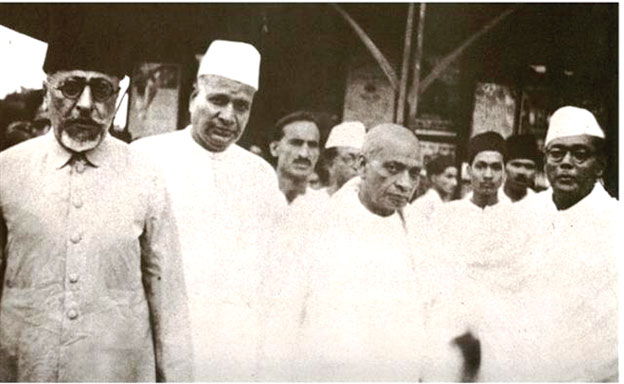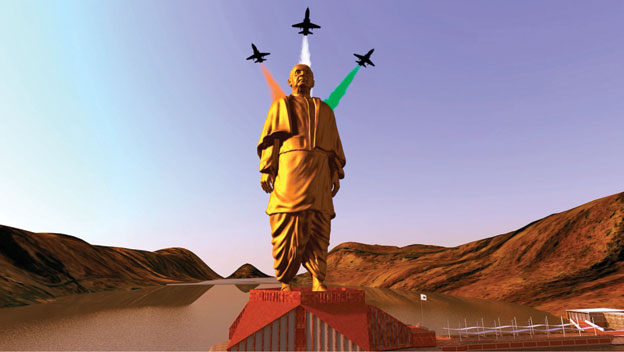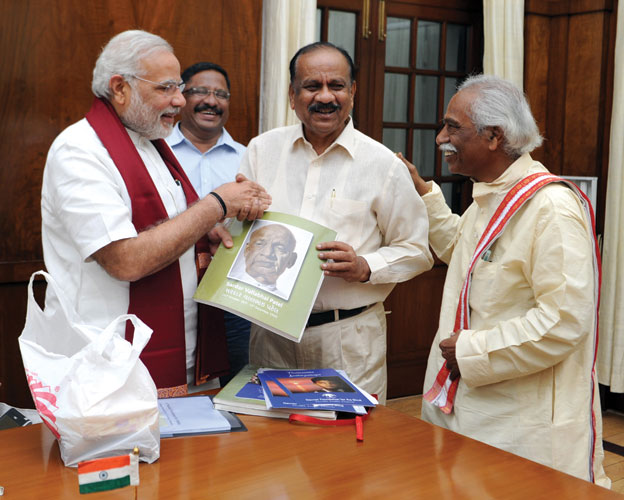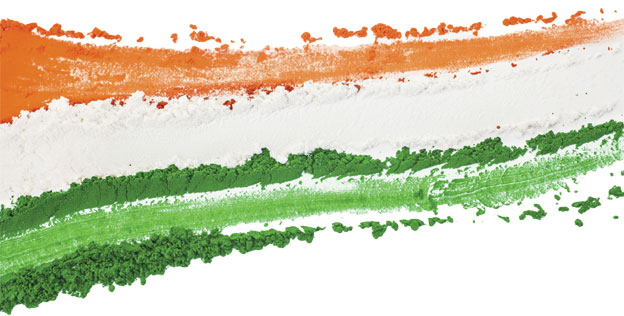(Above): A portrait of Sardar Patel on his 74th birthday, 1949. [Wikimedia Commons]
Raised in the countryside of Gujarat, Vallabhbhai Patel, a successful lawyer, organized peasants from Gujarat in non-violent civil disobedience against oppressive policies imposed by the British Raj, becoming one of the most influential leaders in Gujarat in pre-independent India. He rose to the leadership of Indian National Congress and was at the forefront of rebellions, organizing the party for elections in 1934 and 1937, and promoting the Quit India Movement.
As the first Home Minister and Deputy Prime Minister of India, Patel organized relief for refugees in Punjab and Delhi, and led efforts to restore peace across the nation. Patel took charge of the task to forge a united India from the British colonial provinces allocated to India and more than five hundred self-governing princely states, released from British suzerainty by the Indian Independence Act 1947. Using frank diplomacy, backed with the option and use of military force, Patel’s leadership persuaded almost every princely state. Often known as the “Iron Man of India” or “Bismarck of India,” he is also remembered as the “Patron Saint” of India’s civil servants for establishing modern all-India services.
Vallabhbhai Patel spent years away from his family, studying on his own with books borrowed from other lawyers and passed the bar examination within two years. He practiced law in Godhra, Borsad and Anand while taking on the financial burdens of his home in Karamsad, Gujarat.
In 1917, Patel won an election to become the sanitation commissioner of Ahmedabad. While often clashing with British officials on civic issues, he did not show any interest in politics.
He was deeply impressed when Gandhi defied the British in Champaran for the sake of the area’s oppressed farmers. Against the grain of Indian politicians of the time, Gandhi wore Indian-style clothes and emphasized the use of one’s mother tongue or any Indian language as opposed to English. Patel gave a speech in Borsad in September 1917, encouraging Indians nationwide to sign Gandhi’s petition demanding Swaraj or independence from Britain. Meeting Gandhi a month later at the Gujarat Political Conference in Godhra, Patel became the secretary of the Gujarat Sabha or the Gujarati arm of the Indian National Congress.

(Above): Maulana Azad, Jamnalal Bajaj, Sardar Patel (third from left, in the foreground), Subhash Chandra Bose and other Congressmen at Wardha. [Wikimedia Commons]
Supported by Congress volunteers Narhari Parikh, Mohanlal Pandya and Abbas Tyabji, Vallabhbhai Patel began a village-by-village tour in the Kheda district, documenting grievances and asking villagers for their support for a statewide revolt by refusing the payment of taxes. He emphasized potential hardships with the need for complete unity and non-violence despite any provocation. He received enthusiastic responses from virtually every village. Patel organized a network of volunteers to work with individual villages, helping them hide valuables and protect themselves during raids.
Thousands of activists and farmers were arrested, but Patel was not. The revolt began evoking sympathy and admiration across India, including with pro-British Indian politicians. The government agreed to negotiate with Patel and decided to suspend the payment of revenue for the year, even scaling back the rate.
Patel emerged as a hero to Gujaratis and was admired across India.
In 1920, he was elected president of the newly formed Gujarat Pradesh Congress Committee.
Patel supported Gandhi’s Non-cooperation Movement. He toured the state to recruit more than 300,000 members and raise over Rs. 15 lakh in funds. He also supported Gandhi’s controversial suspension of resistance in wake of the Chauri Chaura incident. He worked extensively in the following years in Gujarat against alcoholism, untouchability and caste discrimination, as well as for the empowerment of women.
In the Congress, he was a resolute supporter of Gandhi against his Swaraj critics. Patel was elected Ahmedabad’s municipal president in 1922, 1924 and 1927. During his terms Ahmedabad was extended a major supply of electricity and the school system underwent major reforms. Drainage and sanitation systems were extended throughout the city. He fought for the recognition and payment of teachers employed in schools established by nationalists (out of British control) and even took on sensitive Hindu-Muslim issues.

(Above): Handout of a still image from video showing an artist’s rendering of a statue of Sardar Vallabhbhai Patel to be constructed in Gujarat, provided by Information Department, Gujarat State, Oct. 31, last year. [Information Department Gujarat State | Handout via Reuters]
When Gandhi was in prison, Patel was asked by members of Congress to lead the satyagraha in Nagpur in 1923 against a law banning the raising of the Indian flag. He organized thousands of volunteers from all over the country in processions hoisting the flag. Patel negotiated a settlement that obtained the release of all prisoners and allowed nationalists to hoist the flag in public.
Historians believe one of Patel’s key achievements was the building of cohesion and trust amongst the different castes and communities, which were divided on socio-economic lines.
In April 1928, Patel returned to the independence struggle from his municipal duties in Ahmedabad when Bardoli suffered a serious famine and steep tax hike. Despite arrests, seizures of property and lands, the struggle intensified. It was during the struggle and after the victory in Bardoli that Patel was increasingly addressed by his colleagues and followers as “Sardar.”
As Gandhi embarked on the Dandi Salt March, Patel was arrested in the village of Ras and was put on trial without witnesses, with no lawyer or press allowed to attend. Patel’s arrest and Gandhi’s subsequent arrest caused the Salt Satyagraha to greatly intensify in Gujarat as districts across Gujarat launched an anti-tax rebellion until Patel and Gandhi were released.
On the outbreak of World War II, Patel supported Nehru’s decision to withdraw the Congress from central and provincial legislatures, contrary to Gandhi’s advice, as well as an initiative by senior leader Chakravarthi Rajagopalachari to offer Congress’s full support to Britain if it promised Indian independence at the end of the war and install a democratic government right away. The British rejected Rajagopalachari’s initiative, and Patel embraced Gandhi’s leadership again.
While Nehru, Rajagopalachari and Maulana Azad initially criticised Gandhi’s proposal for an all-out campaign of civil disobedience to force the British to Quit India, Patel was its most fervent supporter. The AICC approved the campaign on August 7, 1942.
Patel made a climactic speech to more than 100,000 people gathered at Gowalia Tank in Bombay (Mumbai) on Aug. 7, 1942.
Historians believe that Patel’s speech was instrumental in electrifying nationalists, who had been skeptical of the proposed rebellion. Patel’s organizing work in this period is credited by historians for ensuring the success of the rebellion across India.

(Above): Prime Minister Narendra Modi releases the biography of Sardar Vallabhbhai Patel in Braille, prepared by Dr. A Saibaba Goud, for the benefit of the visually challenged, in New Delhi, July 23. Bandaru Dattatreya, Member of Parliament can also be seen. [Press Information Bureau]
Though other political parties had opposed the struggle and the British had employed ruthless means of suppression, the Quit India Movement was “by far the most serious rebellion since that of 1857,” as the viceroy cabled to Winston Churchill. More than one lakh people were arrested and many were killed in violence with the police. Strikes, protests and other revolutionary activities had broken out across India. When Patel was released on June 15, 1945, he realized that the British were preparing proposals to transfer power to Indian hands.
In the subesquent elections, the Congress won a large majority of the elected seats, dominating the Hindu electorate. But the Muslim League led by Muhammad Ali Jinnah won a large majority of Muslim electorate seats. The League had resolved in 1940 to demand Pakistan, an independent state for Muslims, and was a fierce critic of the Congress. The Congress formed governments in all provinces except Sindh, Punjab and Bengal, where it entered into coalitions with other parties.
When the British mission proposed two plans for transfer of power, there was considerable opposition within the Congress to both. The plan of May 16, 1946, proposed a loose federation with extensive provincial autonomy, and the “grouping” of provinces based on religious majority. The plan of June 16, 1946, proposed the partition of India on religious lines, with over 600 princely states free to choose between independence or accession to either dominion. The League approved both plans, while the Congress flatly rejected the June 16 proposal.
Gandhi criticized the May 16 proposal as being inherently divisive, but Patel, realizing that rejecting the proposal would mean that only the League would be invited to form a government, lobbied the Congress Working Committee hard to give its assent to the May 16 proposal.
Patel converted Jawaharlal Nehru, Rajendra Prasad and Rajagopalachari to accept the plan. When the League retracted its approval of the May 16 plan, the viceroy Lord Wavell invited the Congress to form the government. Under Nehru, who was styled the “Vice President of the Viceroy’s Executive Council,” Patel took charge of the departments of home affairs and information and broadcasting.
Sardar Vallabhbhai Patel was one of the first Congress leaders to accept the partition of India as a solution to the rising Muslim separatist movement led by Muhammad Ali Jinnah.
When Lord Louis Mountbatten formally proposed the plan on June 3, 1947, Patel gave his approval and lobbied Nehru and other Congress leaders to accept the proposal.
Patel is remembered as the man who united India. He is, in this regard, compared to Otto von Bismarck of Germany, who did the same thing in 1860s.
While encouraging the rulers to act with patriotism, Patel did not rule out force, setting a deadline of August 15, 1947 for them to sign the instrument of accession document. All but three of the states willingly merged into the Indian union, only Jammu and Kashmir, Junagadh, and Hyderabad did not fall into his basket.
Junagadh was especially important to Patel, since it was in his home state of Gujarat and also because this Kathiawar district had the ultra-rich Somnath temple which had been plundered 17 times by Mahmud of Ghazni who broke the temple and its idols to rob it of its riches, emeralds, diamonds and gold.
Patel insisted that if Hyderabad was allowed to continue with its antics, the prestige of the Government would fall and then neither Hindus nor Muslims would feel secure in its realm. After defeating Nizam, Patel retained him as the ceremonial chief of state, and held talks with him.
Governor General Chakravarti Rajagopalachari, Nehru and Patel formed the triumvirate which ruled India from 1948 to 1950.
Patel was a senior leader in the Constituent Assembly of India and was responsible in a large measure for shaping India’s constitution. He is also known as the “Bismarck of India.”
Patel was a key force behind the appointment of Dr. Bhimrao Ramji Ambedkar as the chairman of the drafting committee, and the inclusion of leaders from a diverse political spectrum in the process of writing the constitution.
He was also instrumental in the founding the Indian Administrative Service and the Indian Police Service, and for his defense of Indian civil servants from political attack, he is known as the “patron saint” of India’s services. He also guided Gujarati farmers to create the Kaira District Co-operative Milk Producers Union Limited, which preceded the Amul milk products brand, as a way to skip intermediaries. Patel also pledged the reconstruction of the ancient Somnath Temple in Saurashtra. He oversaw the creation of a public trust and restoration work, and pledged to dedicate the temple upon the completion of work (the work was completed after Patel’s death, and the temple was inaugurated by the first President of India, Dr. Rajendra Prasad).
When the Pakistani invasion of Kashmir began in September 1947, Patel immediately wanted to send troops into Kashmir. But agreeing with Nehru and Mountbatten, he waited till Kashmir’s monarch had acceded to India. Patel then oversaw India’s military operations to secure Srinagar, the Baramulla Pass and the forces retrieved much territory from the invaders. Patel, along with then Defense Minister Baldev Singh administered the entire military effort, arranging for troops from different parts of India to be rushed to Kashmir and for a major military road connecting Srinagar to Pathankot be built in six months.
He strongly advised Nehru against going for arbitration to the United Nations, insisting that Pakistan had been wrong to support the invasion and the accession to India was valid.

For many decades after his death, there was a perceived lack of effort from the Government of India, the national media and the Congress party regarding the commemoration of Patel’s life and work. Patel was officially awarded the Bharat Ratna, India’s highest civilian honor, posthumously in 1991. Patel’s birthday, Oct. 31, is celebrated nationally in India as “Sardar Jayanti.” The Sardar Patel National Memorial was established in 1980 at the Moti Shahi Mahal in Ahmedabad.
He appeared on the cover of Time magazine in their January 1947 edition.
Sardar Patel is the namesake of many public institutions in India. A major initiative to build dams, canals and hydroelectric power plants on the Narmada river valley to provide drinking water, electricity and increase agricultural production was named the Sardar Sarovar.
As someone aptly put it, Sardar Vallabhbhai Patel was probably the finest Prime Minister of his time that India never had.
[Source: Wikipedia.org]